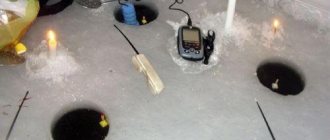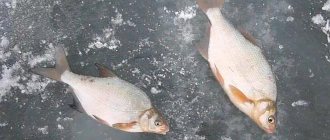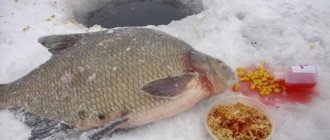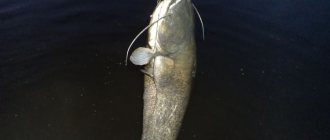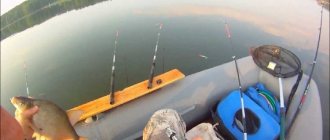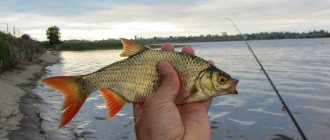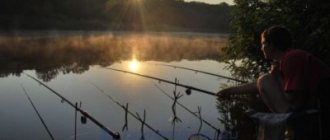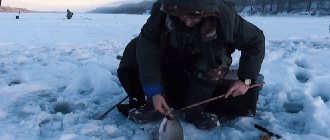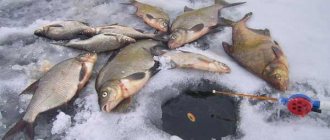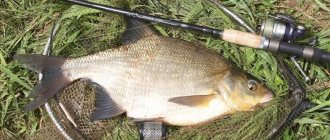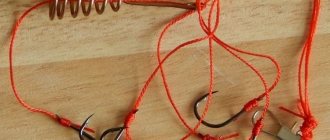☸ Select a location
A successful fishing outcome depends almost 100 percent on where the angler positions himself. If he wants to hide a temporary home from the wind and cold somewhere among the coastal remnants of reeds, then he will have little chance of success. At a depth of less than 1.5 meters, it is pointless to look for bream. You need to start from at least 3 meters, but most often you can get to the wintering flock at around 7-8 meters. In this case, it is necessary to take into account atmospheric pressure indicators: the higher it is, the deeper the fishing object descends. Sometimes you have to get it out from a 15-meter depth.
People have not yet learned to determine the distance to the bottom by eye; using a skein of fishing line with a weight at the end in the cold is inconvenient, so a device such as an echo sounder will not hurt. If you don’t have it in your arsenal, then you can simply ask local ice fishing enthusiasts and get enough information to make the right choice.
Since it is quite difficult to determine a promising place in the dark, especially on an unfamiliar body of water, it is advisable to arrive for fishing before dark, 2-3 hours before dusk. In this case, if the first point is unsuccessfully selected, there will be time to move to another.
Specifics of fishing
Most large reservoirs are artificially regulated water systems, which makes finding fish much more difficult. Even a slight rise or fall in the water level affects the flow under the ice. It can speed up, slow down or shift. Since fish are very dependent on these factors, they are forced to constantly adapt to changing conditions.
Success in winter bream fishing is, to a large extent, ensured by the ability to read a body of water. As you know, large bream is a very cautious fish, despite its size. During daylight hours, this caution manifests itself especially clearly. If a bunch of noisy fishermen have gathered on the ice (a very common sight), then there is usually no talk of catching a large bream. In the best case, the small bream will bite, especially at shallow depths.
In this regard, night fishing is good because of its silence. The holes have been drilled since the evening, and there are usually few people on the reservoir. At this time, the probability of catching a large night bream is quite high.
On a note! In highly elongated reservoirs, schools of bream often stay in areas of the flooded river bed. As soon as the current strengthens even a little, the bream comes out to feed in areas adjacent to the riverbed.
I think this is explained by the instinct of the fish. After prolonged rain, the water level in the river rises and the current intensifies, bringing in various food.
Selecting a location
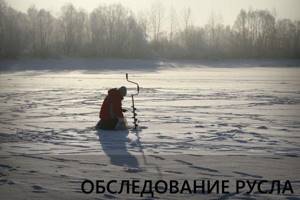
Be that as it may, when searching for schools of bream in winter you have to stick to the riverbed. However, the fish go to areas adjacent to the riverbed to feed, where the depth can be significantly shallower. It is in such places that the appearance of bait and tasty bait will look more natural and appropriate for the bream.
In relatively shallow water bodies, with a depth of up to 4 meters, you should look for bream on the riverbed itself.
To determine the optimal place for night fishing for bream in a tent, it is best to devote the morning and afternoon to fishing beforehand. When, say, out of 20-30 holes only 5-10 hatch, the situation under the ice becomes clearer. It is convenient to carry out daytime reconnaissance with the help of a devil. If a fish stands on a point, it will definitely show itself with at least a poke. Even if a small bream slowly “sits” on the devil, this certainly means that a large one is not nearby.
We recommend reading: Catching chub with a spinning rod
Search for active fish
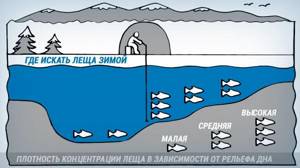
At first, finding fish may seem too difficult, because the area being fished covers a large area. But as the half-kill bream pecks, this area narrows. You shouldn’t waste time and energy on “dead” holes.
If the activity of the “plywood” is very low, you can try shaking a small jig with a bunch of bloodworms. There is no need to try fishing with a hanging jig or fishing from the bottom. This fishing is exploratory and by fishing different layers with frequent movements, there is a greater chance of finding good fish.
Since during the day the average size of trophies is much smaller, you need to focus on the outcrops of large undergrowth. If you can understand how it behaves during the day, it will become easier to catch it at night. And seasoned bream is always next to a school of bream. Therefore, having identified several “shot” holes during the day, all that remains is to choose the best one.
During prolonged thaws, the movement of bream throughout the reservoir becomes more active. These days it is better to look for it in the so-called watering areas, places where roaches are caught in winter. These are flat muddy areas with an average depth of 4–5 meters and a flat bottom. If the warming is strong and melt water begins to get into the holes, the bream will probably be at half-water. It will be useless to fish from the bottom even at night; it is better to fish by shaking, especially by lowering the jig.
Unfortunately, despite the fact that bream begin to move more during the thaw, the bite is short-lived. Bites often look like an uncertain pressure of the nod, whereas in cold weather there are very confident rises.
Note! The task of an experienced fisherman is to discover bream trails. It is known that this schooling fish strictly adheres to certain routes.
Alas, if you happen to be far from the fish road, then most likely the night trophy will only be small “plywood” and it will not be a matter of groundbait, fishing line or bait. We can say that without knowledge of the reservoir, at least approximately, fishing completely turns into a lottery.
☸ Parking arrangement
Night fishing for bream in winter requires careful preparation. It can take a long time before the first bite, and you need to spend it in a comfortable environment. First, the required number of holes are drilled at the selected location (usually three or four), after which you can begin setting up the tent, always with the back side facing the wind. This way it will remain stable even with strong gusts.
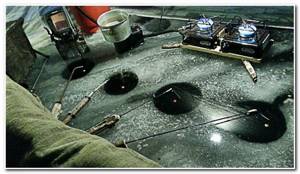
The skirt of the tent should be sprinkled with snow and trampled down well - this will further increase its wind resistance and ensure proper thermal insulation. For heating, you can use a variety of heat sources, from a paraffin candle to a gas stove. True, you cannot use them all the time, since in a confined space an open flame quickly “eats” oxygen. You also need to take care of the lighting of the tent. It is better if the lantern is fixed at the top and in the middle. At the final stage, you need to conveniently arrange all the fishing accessories inside: place the box opposite the holes, put a box with bait on the left, a hook on the right, and so on.
Catching bream with bait in winter
Bream is considered a schooling fish, but due to its large size it prefers to settle in large areas with sufficient free space. Given this feature, you should not expect a big catch if you sit near just one hole.
Note: It is not recommended to stay only near one hole in the ice because the presence of a person is invariably accompanied by a certain noise and light, and this, in turn, does not contribute to active biting.
If you do not want to constantly move across the ice from one hole to another, the only possible option is to catch bream with bait. At the same time, feeding the fish should be generous and regular so that the fish gather in one place (Figure 2).
Baiting bream has its own characteristics:
- Correctly carried out feeding can lead to the fact that the bite will begin the very next day. But it often happens that a fisherman has to spend several days on bait before the fish reacts to it.
- Keep in mind that the larger the bream, the later it will react to food. In addition, large specimens are most often restrained in biting.
- The size and weight of the fish directly affects the choice of food products and fishing gear. For example, bream up to a kilogram quite willingly eat any food and bite well on any type of gear. Large specimens, weighing one and a half kilograms or more, are picky eaters and require the use of delicate gear.
- With the arrival of cold weather, all fish, including bream, switch to food with a high protein content. That is why animal products must be included in bait.
- It is best to use bloodworms as the basis for complementary feeding, and complement it with breadcrumbs, semolina or sunflower cake. Products of plant origin are necessary to create a cloud of nutritious turbidity around the bloodworms, which will lure the bream to the fishing spot.

In general, the success of catching bream in winter with bait directly depends on the amount of bloodworms in the bait. You can also add maggots or crushed worms to it, but such food may not be effective enough for catching large specimens. Experienced fishermen also do not recommend using special flavors in winter: their bright and strong smell can have the opposite effect, and cautious bream will simply leave the fishing spot.
If you don’t have fresh bloodworms, you can easily replace them with frozen ones. To make such bait, you need to take a plastic mold, fill it with water, sand and bloodworms, and put it in the freezer to harden. When fishing, all you need to do is tie these cubes to a fishing rod and lower them to the bottom. This bait has several advantages. Firstly, it melts slowly and holds the bream in the fishing spot for a long time. Secondly, it can be prepared for future use and stored in a regular freezer, and the finished bait will not lose its taste even after long-term storage.
When planning to go winter fishing for bream with bait, keep in mind that you need to give the fish food one or two days before the intended catch. It is important not to overdo it with bait. If parts of food remain in the water, they will quickly begin to rot, and this unpleasant smell will scare the fish away from the fishing spot.
☸ What to catch
To catch bream at night from the ice, both passive and active gear are used, that is, floats with a hook and jigs. Jigs are rarely used at night, since in the dark the feeding bream is guided mostly by smell and does not see the action of the bait, although it can feel its vibration. Jigs with a fluorescent coating have proven themselves to be the best for night fishing for bream.
As for the float rod, despite the known power of the fishing object, it should be as delicate as possible. The hook is miniature, like for bream - No. 18 or, in extreme cases, No. 16, but no more. Just enough to plant half a dozen bloodworms. The weight used is also light, in the range of 0.25-0.5 g, and accordingly the float should be very small.
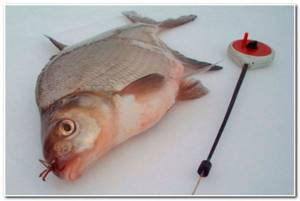
To some, such a rig will seem bleak, but not bream-like; moreover, before, bream fishermen would have laughed heartily at it, but not now. Recently, this fish has become noticeably wiser and avoids rough, heavy equipment. He approaches the bait and touches the bait, but at the slightest resistance he instantly throws it away.
The bite is expressed in a barely noticeable raising of the float, which immediately returns to its original position. Everything is clear, the bream felt an unnatural heaviness and spat out the bait. On a thick fishing line, it is impossible to lower the delicate equipment to the bottom, so you have to break the psychological barrier and install monofilament with a diameter of 0.12-0.14 mm. Many people manage to lift bream even on a 0.10 mm fishing line. Of course, fishing takes a long time, you need to pull slowly, without sudden pulls or twitches. If the fish resists too much, you have to give up the line and then bring it back to the hole, centimeter by centimeter. But it’s for this moment, when the outcome of the struggle depends on the strength of the nervous system, that we go fishing.
Fishing tactics
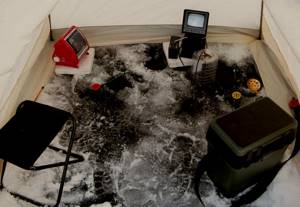
Night fishing differs from day fishing, first of all, in the inactivity of the fisherman and comfort. The place has already been carefully verified, the holes have long been drilled, the tent has been pitched. There is a gas stove burning inside the tent, a lamp is on, and only when you go outside do you realize that winter is all around.
Recommended reading: How to catch a large crucian carp
Tackle
Almost any winter fishing rod is suitable for night bream fishing. It is best to use 2-3 pieces at a time. A larger number will most likely lead to confusion of equipment. And it’s much more difficult to keep track of a large number of floats.
Considering the likelihood of a large bream biting, there is no need to go small with the diameter of the fishing line. A modern fishing line with a diameter of 0.14-0.16 will be sufficient for these purposes.
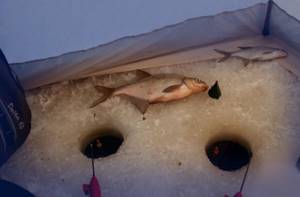
For an assortment, it makes sense to equip each rod differently. For example, you can put a regular jig on one, and a small hook with a sinker on the other. The third fishing rod can be equipped with a so-called rocker, a good bottom rig for catching bream at night.
The fishing itself most often occurs only from the bottom; anglers only occasionally play along with a fishing rod. Fishing occurs in waves, the bite starts suddenly, and ends just as suddenly.
Bait
Bait is mainly used in volumetric form: a bunch of bloodworms, maggots or boiled jigsaw. It can be useful to attach a piece of boiled egg white to the hook. Vegetable attachments work somewhat worse in winter, however, you can attach a piece of bread or semolina. After all, several fishing rods allow you to experiment with bait, and the preferences of bream can change at any time.
Biting and fishing
The bites look like the rise of a float and are quite difficult to miss. At this time, the bream confidently lifts the bait from the bottom and gradually retracts it. There is no point in delaying cutting. As soon as the float began to rise confidently or came to the surface, you need to make a hook.
You need to fish out large fish carefully, trying not to let the line weaken. The greater the depth in the fishing area, the easier it is to control and tire the bream.
Video about catching large bream with an egg
☸ Groundbait and bait
Successful fishing for bream in the dark is based on simple tactics: searching for a promising place, which was already mentioned above, and attracting fish under the hole with the help of bait. It is important to use a fresh and high-quality winter mixture; summer compositions with strong aromatic substances are not suitable for such fishing. Practice has shown that in its “pure” form, store-bought baits work somewhat worse than in combination with food bloodworms. The reason is known - bream, like most other peaceful species, prefers protein foods in winter.
Therefore, it is advisable to mix bait with bloodworms in a 2:1 ratio. The mixture will attract fish, and the larvae will stimulate the appetite. To achieve the desired result, you will need up to 3 kg of bait. This amount is quite enough for one night. Half will immediately be used to feed the point, and the second must be distributed in such a way that it is enough for additional feeding from the moment the bite worsens until the morning. If the bait mixture runs out earlier than planned, you can supplement the bream with bloodworms alone, periodically throwing a pinch of larvae into the hole. They also serve as a nozzle. If the bite is active, the bream grabs greedily and confidently, then it is recommended to put several pieces on the hook at once. Gourmet also loves white baits, so maggots should be in stock. In some cases, he takes them no worse than in the warm season.
Bait of bream
Bait can be very useful when fishing for bream in winter, but its use is not always so clear. Bream is a fish with fairly established “paths” and habitats and, especially in winter, no bait is often able to move it from them. On a homogeneous bottom surface, bait usually attracts fish from an area with a radius of 5 - 10 m. As for its quantity, for example, bait sufficient for a good bite on the first ice will be too much for sluggish fish in the dead period of mid-winter. Therefore, you need to try all the time.
Groundbait recipes
There are no definitely working recipes for which bait to use. The basic principles of its creation are as follows:
- the bait must contain bloodworms, at least 30–50 g per liter of bait;
- The smell of the bait should be attractive to the fish, but not too much, and in different bodies of water, these smells are different, you need to try it;
- The calorie content of the bait should correspond to the activity of the fish during a given period;
- there should be no lumps in the bait; to do this, it must be rubbed through a sieve;
- Winter bait does not require a binder.
Taking all this into account, let’s look at a few simple, folk bait recipes:
Bait for bream with peas
As you know, peas are one of the favorite baits of bream; the first bait is made on its basis.
Ingredients:
- breadcrumbs (ordinary grated ones can be used) – 500 g;
- roasted sunflower seeds – 75 g;
- oat flakes – 100 g;
- crushed polished peas – 200 – 300 g.
Pour water into the pan in a 2:1 ratio with peas. When the water boils, add the peas and cook over low heat until they are cooked into a homogeneous mass.
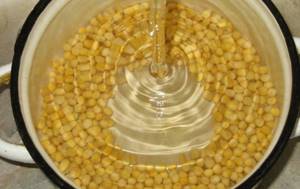
Rusks, oatmeal and seeds are passed through a meat grinder or coffee grinder. Mix the ground seeds, crackers and flakes in a bowl or basin and then pour them with boiled pea porridge.
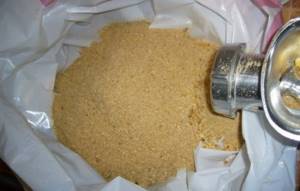
Knead the resulting mixture with your hands until smooth and transfer it to a plastic bag. The resulting bait should easily form into a lump and disintegrate; when it gets into the water, it gives a good cloud of turbidity that attracts fish.
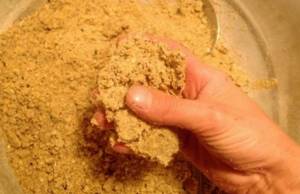
Groundbait with bloodworms
The second mixture, in addition to the classic millet and crackers for bream, contains bloodworms, so it is advisable to use it when the fish is more active, on new ice or at the end of winter.
Ingredients:
- millet – 500 g;
- bread crumbs, regular or bread crumbs - 300 g;
- roasted sunflower seeds or makukha – 100 g;
- sunflower oil – 50 g;
- bloodworm – 150 – 200 g.
Cook the porridge in a 1:2 ratio with water until the water completely disappears. We pass the crackers through a meat grinder, and then fry the resulting crumbs in sunflower oil. We also pass the seeds through a meat grinder. Mix all ingredients in a bowl or immediately in a thick plastic bag. Already while fishing, we add small or chopped large bloodworms to the mixture.
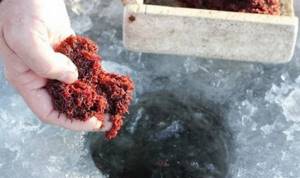
Groundbait with bloodworms
Video recipe: Effective bait from pearl barley and millet
How to feed properly
When fishing for bream in winter, you should remember that the earlier the bait is introduced, the better. In winter, the fish are not very active, and accordingly, after feeding, they react longer. Taking this into account, experts advise feeding after dark for fishing at dawn, and before sunset for night fishing. During the day, the bite begins about an hour after feeding the hole.
The bait is thrown using special feeders. Sometimes the main and supplementary feeders are separated, the latter being smaller in size.
It is believed that bream requires a lot of bait, but here we need to take into account what we feed and at what period. The more active the fish, the more bait you need. It is most practical to initially use vegetable bait, with a small amount of bloodworms, and then keep the fish at the hole in small (3 - 5 g) portions. When supplementary feeding, the feeder should be opened not at the bottom, but a couple of meters higher, so as not to scare away the fish.
☸ Features of biting
The bites of bream are original, they are completely different from the bite of other fish. As a rule, this is a slight trembling, after which the float begins to slowly rise and fall on its side. It is at this second that you need to make a soft sweep and be ready to absorb the first blow with your hand. It is more difficult to hook a fish when the float begins to move to the side. This suggests that caution has prevailed, she sensed something was wrong and is trying to spit out the bait.
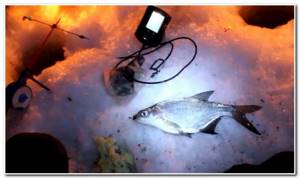
Catching bream in winter on the current
One of the most popular methods of winter bream fishing is fishing from ice in the current using a combine. To do this, use the most common winter fishing rod with a nod (Figure 4).
This gear has its own design features:
- A feeder is attached to the main line through a swivel with stoppers. The length of the leash should be 15-20 cm.
- At a distance of 5-6 meters from the feeder, an insert with 3 hooks is made. The length of such an insert should be one and a half to two meters.
- The first hook should be located at the end of the line. Next, a weight of 2-3 pellets is attached to it. This will help the tackle sink to the bottom faster. After this, two more hooks are placed at an equal distance from each other and from the weight.
- It is important to choose the right fishing line thickness. The main one should be no more than 0.3 mm; for the leash, take a piece of fishing line 15 cm long and 0.18-0.22 mm thick.
- From additional equipment you will need: 3 sharp hooks with a luminous drop of phosphorus numbered 5-8, a closed feeder weighing 90-120 grams, as well as a small lead weight for it so that the feeder does not drift away from the fishing spot with the current.
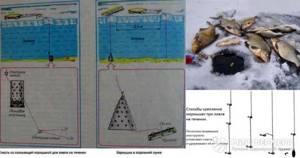
The technique for catching bream on the current in winter is quite simple. First, you need to put a sufficient amount of food in the feeder, and attach bait of animal origin (for example, bloodworms or maggots) to the hooks. It is advisable to use live larvae, since they will attract bream with their movement (Figure 5).
⍟ Useful tips
- On frosty days, bream bite sluggishly and reluctantly, and sometimes even refuse to eat, postponing this event until more suitable weather conditions. This is what is commonly considered to be a thaw. If the temperature is approaching zero and weather forecasters do not promise any sudden changes, you can safely go fishing. The best time for fishing is from midnight to 4 am, and when the weather is favorable, the fish are active all night.
- If the landing of the first hooked bream was successful, but too noisy, most likely the fighter scared away the entire flock with its resistance. In this case, it makes sense to move to another promising place, rather than wait for happiness to come on its own. Moreover, winter nights are not as long as they might seem.
- It happens that fish ignore stationary tackle. If she was definitely caught here yesterday, but doesn’t want to today, you can try to provoke her with a jig with a live bait. You should play with artificial bait with bloodworms in the bottom layer, where bites most often occur. It is advisable to accompany the wiring with smooth blows on the bottom surface to raise a little turbidity.
Catching bream at night in winter is an interesting and exciting activity. Sometimes so much so that the fisherman completely forgets that he is in the frost and cold, and not at home on the sofa in warmth and comfort. This should not be allowed, otherwise fishing will bring a lingering cold along with the catch.
Catching bream in winter in a tent
Fishing in a tent is ideal for catching bream. The fact is that the situation when the feeding area is limited to just a few holes is not so uncommon. To protect yourself from dampness or cold wind, it is better to immediately take a tent or other similar shelter with you (Figure 3).
Note: Do not think that winter fishing without moving on ice will not bring the desired result. Such stationary fishing can also be very productive.
Quite often, the use of a tent in fishing is explained by the circumstances themselves: for example, when the area with baited bream is limited in area or there are many anglers on the ice. In addition, this method will be useful for those who do not have the opportunity or desire to constantly carry buckets of bait to the fishing spot.
Catching bream in winter in a tent also has its own characteristics.
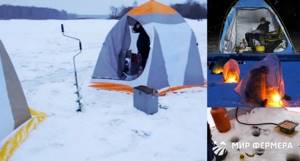
Figure 3. When fishing in a baited area, you may need shelter - a tent
First of all, you should take into account that in this case you will have to limit yourself to just a few holes and a small set of gear. The fact is that a large number of hanging lines can arouse suspicion in fish, especially large ones, and it will simply leave the baited place. In addition, there will be a high risk of all the gear becoming tangled at the same time, and you will not only lose a possible catch, but also seriously damage the gear. It would be optimal to drill two or three holes in a baited area, place a tent in close proximity to them and throw one fishing rod into each hole. In this case, the tent should be positioned in such a way that you have a good view of all holes in the ice at the same time.
Tackle for catching bream in winter
The choice of gear for winter bream fishing directly depends on the type of reservoir and the chosen fishing method (Figure 7).
We will try to provide universal tips on selecting gear:
- Fishing rod: you will need a fishing rod with a highly sensitive nod, a special winter float fishing rod with a hard whip and special knives for installation on ice, as well as a so-called “filly” equipped with a motive and a foam handle.
- Fishing line: the ideal option would be monofilament of the smallest diameter. The thickness should be in the range of 0.16-0.2 mm, however, the final choice of fishing line depends on the size of the bream and the chosen fishing method. It should be taken into account that a thin fishing line is practically not carried away by the current and is less noticeable in the water.
- Hooks and jigs: if you prefer winter fishing with a float, take hooks from 5 to 8 numbers (according to the international classification). It is advisable to choose black or red hooks with a long shank. From jigs, it is better to choose “devils” with a body in the form of a cone or roller, since they are the ones that have maximum efficiency.
- Float: selected according to its carrying capacity, which depends on the weight of the jig and the weight with the hook. It is better to choose brightly colored floats, as they are more visible against the background of dark water.

When choosing gear, you should also take into account the ease of use. When catching bream with a nod fishing rod, you will have to constantly play with the jig to attract fish, so try to select the tackle in such a way that your hand does not get tired from monotonous movements.
You can see what winter bream fishing looks like in practice using the video.
On the pond
Fishing for bream on a pond is significantly different from fishing on a river or other bodies of water. The reason for this is that if in rivers bream stays in approximately the same areas throughout the day, then in stagnant water, as happens in ponds, we can observe its clearly defined migration.
As was said, in winter bream behaves rather inactively, but there are exceptions when the fish is in the pond. In a pond, bream prefers to behave warily and reacts well to various noises or the smallest splashes of water.
To get a good catch, experienced fishermen advise using the following tactics when fishing on a pond:
- To begin with, you should drill 3-4 holes on the surface of the pond, approximately 15-20 centimeters in diameter. The distance between holes must be maintained at 5-10 meters, since drilling holes at a distance of 2-3 meters from each other does not make sense.
- After preparing the holes, it is imperative to feed them.
- Then all that remains is to wait for the profit; usually the wait lasts 30 minutes.
Tricks
Many people know that bream is the desired catch of most fishermen. However, not many of them know how to leave fishing with a good catch, because catching bream is not so easy. To do this, experienced fish “hunters” have their own tricks, which we will share below.
- Bream is a large fish. If, when going bream fishing, you have prepared small bait, then it is recommended to replace it with a larger one, because the fish may simply not notice it. In such cases, experienced fishermen advise using whole boiled peas.
- If we talk about bait, bream like to see maggots or ordinary red worms in their diet.
- Of course, as when catching any other fish, the feeding area is important. To choose a place, you need to know in which places the bream lives, take into account the topography of the bottom of the reservoir, and in what place you need to cast the fishing rod.
We invite you to watch a video about the secrets of successful winter bream fishing:
Top dressing
Sometimes the correct selection and preparation of feeding while fishing plays a greater role than the experience of the fisherman . In order to prepare the correct feed, you should carefully study the preferences of a particular fish, in this case, bream.
Traditional recipe for feeding bream: You will need :
- - Makuha.
- - Crackers.
- - Fine sieve.
- - Bloodworm.
Cooking method:
- You need to take flour and crackers for breading purposes in a ratio of 5/5.
- Next, sift the ingredients through a small strainer.
- Once at the pond, it is recommended to also add bloodworms.
- To guarantee a good catch, you should drill a hole in the pond and constantly feed the bream from it. This way the fish will know that there is always food in this place, which will influence the frequent visits to this hole.
